"Pan megagroup" - An update on recent achievements and the future of quantum networks
Jiuzhang 4.0, quantum memory breakthroughs, coming satellite constellations and quantum-network-enabled sensing applications
[Edits 2025/09/19, see footnotes for errata]
“Quantum internet” is a buzzword, farther off and more vague in its impact than even fault-tolerant quantum computing. The long-term vision is one of “unconditionally” secure communication, quantum computers interconnected through quantum networking infrastructure, and global-scale quantum sensing arrays.
A recent talk by Professor Jian-Wei Pan on quantum networks helped me get a much more concrete understanding of where we are in this fuzzy vision and had me marvel at the technology demonstrations expected over the next 5-10 years. His talk outlined a vision for quantum communications that goes through, but beyond, scaling quantum key distribution with satellite networks and quantum repeaters, building on accumulated quantum networking technology to realize distributed quantum sensing advantages and new tests for the laws of nature. It strengthened my optimism that quantum networks will be a key building block of the 21st-century information infrastructure.
I just attended the QCrypt quantum cryptography conference in Sanya, China. On a personal level, this conference was fantastic to get up to speed with recent developments and meet some people in the field. After two years at Peking University studying policy aspects of quantum technologies, my next career step is back to more technical work in quantum cryptography.
For this blog, which is more about big picture developments than technical details, I want to share my takes on Professor Jian-Wei Pan’s public lecture on the evening of the third day. I was very impressed not just by the upcoming experimental achievements of his megagroup1, but even more so by the decade+ vision he outlined for quantum networks. Given his track record, this vision matters: Professor Pan is not just a distinguished scientist that with all kinds of accolades and record-breaking achievements, but he has also been the main public visionary and administrator behind China’s quantum roadmap, directly endorsed by Xi Jinping and heading China’s National Quantum Laboratory.
Before I get into his talk, let me give a shoutout to the organisers of QCrypt. It was a great conference. While I often write about quantum through the lens of underlying politics and fragmentation in the technological landscape, this conference was a good reminder that most researchers still primarily care about good ideas and openly discuss their work and methods. Politics takes a distant background. While I don’t think that scientists can or should be completely detached from politics, the collaborative spirit of pushing a field forward is very admirable in academia. Next year’s QCrypt will be in Ottawa, Canada; maybe I can make it again.
Now, let me summarize my thoughts on professor Pan’s talk.
On a high level, the incredible technological and scientific success of Pan’s megagroup is a for me a story of:
Persistent persistent pursuit of long-term objectives. For example, Pan shared that around 2003, he realized that building quantum memories–needed for long-distance secure quantum communication–is extremely hard. Hence, he started looking for more efficient ways. One solution he settled on was using free-space communication with quantum satellites, which was famously realized with the Micius satellite 13 years later. Of course, this doesn’t mean professor Pan gave up on quantum memories. Indeed, he presented two breakthroughs that I will talk about below. Still, the journey is far from over: He expects a practical quantum repeater at 1000 km scale to be feasible in 5-10 years.
Strategic accumulation of know-how. This refers to the many sequential achievements and technologies developed by Pan’s megagroup that build on top of each other. For the Micius satellite, Professor Pan outlined a decade-long journey of ground tests supported by the Chinese Academy of Sciences (CAS) since 2003, with the first free space tests in 2005.2 The *strategic* approach to some of this accumulation is definitely not without controversies. For example, Pan’s time in Heidelberg, Germany, which he leveraged to cultivate capabilities in cold atom quantum memories at USTC, has been framed by some Western analysts as an “exploitation of Western government funding.”3 Ditto for hiring Chinese researchers from abroad through “talent plans” and the surrounding controversies.
Interdisciplinary integration. With research activities covering nearly all quantum technologies, accumulated know-how is not siloed up, but enables breakthroughs in adjacent fields. For example, Pan highlights how they made use of multi-photon interferometry technologies developed for quantum communications in building photonic quantum computing prototypes (the “Jiuzhang” quantum computers). In 2020, this famously culminated in the world’s second quantum computing advantage experiment. This interdisciplinary integration is supported by productizing technological building blocks (through the company QuantumCTek and others) and through large interdisciplinary flagship projects.
Flagship projects. Large technological achievements that mobilize China’s vast engineering resources and broad scientific excellence for experimental breakthroughs or large-scale applications. Past examples include the Micius satellite and the national Quantum Key Distribution (QKD) long-distance backbone network, now stretching more than 10’000 km. The prospects here are truly dazzling, with Pan mentioning a quantum satellite constellation, a large geostationary quantum satellite (2027/28) and various applications of quantum networking technology to sensing: Ultra-precise time synchronisation at global scales, quantum-enhanced telescope arrays and, in 10-15 years, outer space experiments such as for the detection of gravitational waves at low frequencies. (More on these below.)
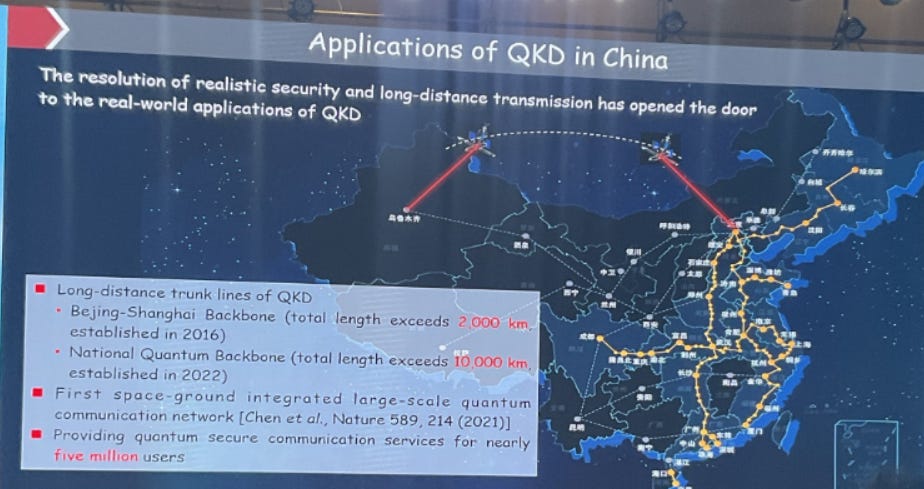
Professor Pan’s talk first summarised the development of quantum key distribution, with a special emphasis on the two challenges of practical security (fixing side-channels that come from imperfect implementation of theoretically secure protocols) and extending the range of quantum communication. After presenting recent achievements in quantum repeaters and Jiuzhang 4.0, he gave an overview of applications and future roadmaps for quantum networks.
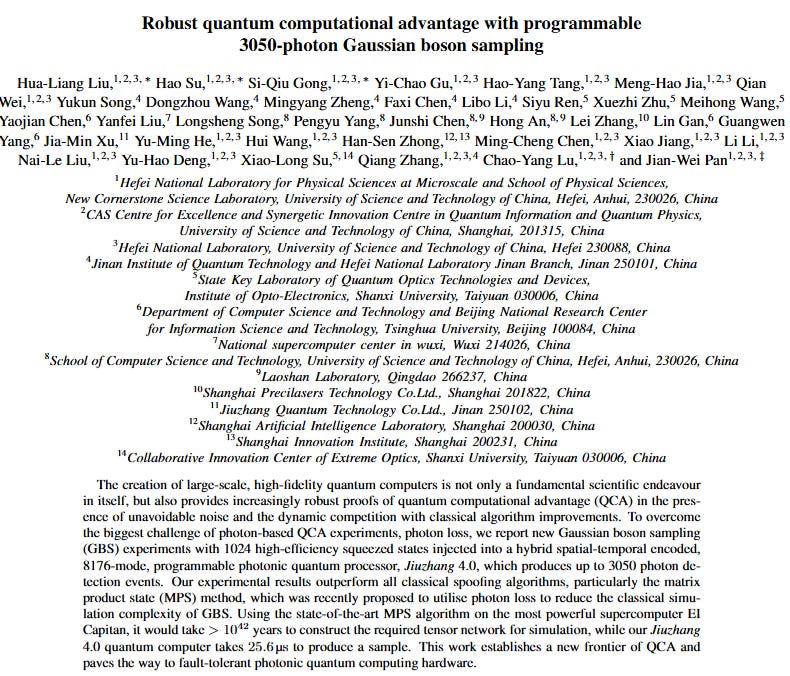
Note, that the talk focused on quantum communications and adjacent technologies. Hence, while photonic quantum computing was mentioned as well as the possibility of connecting quantum computers through a “quantum internet,” no updates were given on other quantum computing modalities pursued by Pan’s group, such as the recent neutral atoms record or progress in quantum error correction on the Zuchongzhi superconducting quantum computing platform.
The missing building block: Quantum repeaters
This section is a tiny bit technical; if you just want to know about the applications, you can skip to the next section on applications and prospects.
Current quantum communication technology still faces significant limitations in range and (for cryptography applications) practical security. Optical communication in fibres is range-limited by photon loss. For example, commercial quantum key distribution (QKD) implementations are generally limited by photon loss to around 100 km. Securely generating keys beyond that range requires a chain of trusted nodes, which increases cost and can present security issues. New protocols such as Twin-Field QKD or mode-pairing QKD push this range closer to 500 or even 1000 kilometres, but don't change the fundamental limitation from fibre loss.
Transmitting quantum signals through free space instead of fibres is one partial solution. This motivated the Micius satellite, launched in 2016 and demonstrating satellite-enabled QKD at over 1’000 kilometres. In 2022, Pan’s megagroup followed up with a miniaturised version, Jinan-1, which demonstrated QKD at over 10’000 kilometres. Currently, soon a decade after Micius was launched, multiple other countries are close to first demonstrations of quantum satellites. However, unlike the Micius satellite, which directly distributed entangled photon pairs, Jinan-1 and many other projects only communicate with one ground station at a time, acting as a “space postman” – that is, a trusted node.
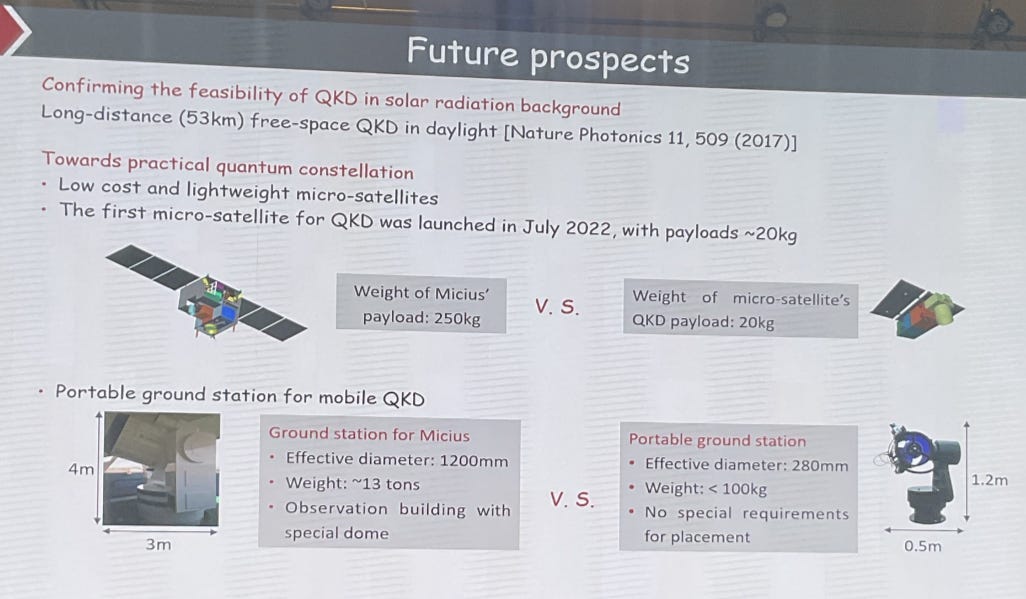
In theory, the requirement for trusted nodes and limitations on range can be completely overcome with quantum repeaters. In classical communications, weak signals can be “replenished” by signal repeaters that read out the incoming signal and resend an amplified version. However, this is impossible in quantum cryptography whose security relies on the “no-cloning” property of quantum mechanics, i.e. the inability to just read out and copy an incoming quantum signal. One way around this is with trusted nodes: If A and C are 200km apart but can only reasonably establish secure keys at a distance of 100km, let’s just place a third party, B, in the middle. Then, A and C can both establish secure connections with B, using him as a man-in-the-middle. But what if we don’t want to trust a man-in-the-middle?
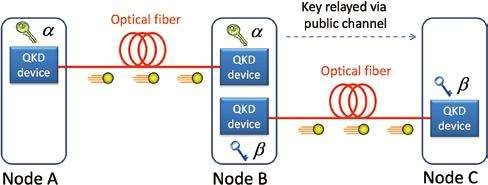
Quantum teleportation provides an alternative quantum method to overcome the need for trusted nodes. The basic idea is that you can again use a man-in-the-middle B, which is “entangled” with both A and C, to create entanglement with A and C instead through “entanglement swapping”. (Entanglement, in turn, can be used for QKD. It is also a crucial “resource” to many other quantum communication applications.)
The great thing about quantum mechanics (more specifically, Bell non-locality) is that, unlike in the classical case, A and C do not have to trust B. As long as the local statistics at the endpoints A and B fulfil some well-defined requirements, we can be assured that no man-in-the-middle, no matter how powerful, ends up with any information about the created keys. Intuitively, quantum entanglement is “monogamous”, that is, you can only be perfectly entangled with one party at a time.

This is connected to something called “self-testing” and “device independence“ in quantum technologies. These are incredibly powerful: Based merely on output statistics of two spatially separated “blackbox devices”, the inner workings of these devices can be characterised to work as intended. As long as quantum mechanics is correct (and complete), we can have truly unconditional security no matter how malicious the manufacturer of our devices, how powerful our adversary or how clumsy the intern who calibrated our photon source … – that’s the idea; of course, if you dig deeper, there are still some assumptions left (e.g. related to isolation of the devices during operation, free will of the operators, or locality loopholes).
In a nutshell, quantum repeaters are the technological building block that allows for entanglement swapping. Hence, quantum repeaters can help us to overcome both range limitations as well as practical security issues by allowing device-independent protocols (DI-QKD). Beyond QKD, quantum repeaters can create entanglement between spatially separated parties, with applications to quantum computing and sensing.
Progress towards quantum repeaters
Apparently (I am a theorist, so I wouldn’t know), building quantum repeaters is quite hard. It requires:
Quantum memories: The ability to preserve stationary quantum states intact for a “long” period of time, called lifetime. To make quantum memories useful, you also need to be able to read and write your memory and ideally interconvert your stationary memory (e.g. state of atoms) efficiently with “flying” quantum information (photons). For example, you may want to tell your quantum memory, “Please swap your stored quantum state to the polarization of a photon and emit that photon.” Hopefully, the quantum memory does as told with high probability, called retrieval efficiency.
Entangling the quantum memory with a photon: You want to send out photons that are entangled with the state of your quantum memory.
Entangling measurement: You want to perform a joint entangling “Bell state measurement” on two incoming photons (needed for the entanglement swapping step in the figure above).
Ideally, once entanglement is established between two distant parties A and C, you would like to “purify” that entanglement, basically using lots of “bad” entanglement to get a few copies of near-perfect Bell states. In summary: Entanglement swapping/quantum teleportation for establishing a “connection”, entanglement purification for cleaning up the connection.
The basic idea of quantum repeaters can be written down in a few lines on a blackboard. But again, making this happen with actual hardware is really hard. Luckily, Professor Pan has been working on this for over two decades. As seen in his slide below, the two metrics “quantum memory lifetime” and “retrieval efficiency” have undergone significant improvements over the years: From 1µs lifetime and 35% retrieval efficiency in 2008 to 220ms lifetime (>5 orders of magnitude improvement!) with 76% retrieval efficiency in 2017.
Now, all this work seems to start paying off. To build a working quantum repeater prototype, Pan’s megagroup simultaneously pursued two quantum memory architectures (because why not): One based on trapped ions, the other one on neutral atoms (both papers appear to be still in preparation). In both cases, the teams successfully established entanglement between quantum memories separated by 100km and used this to demonstrate device-independent QKD (DI-QKD)!
I am no authority on this, but I think that while this isn’t the first time DI-QKD was experimentally demonstrated, it is the first time it was demonstrated beyond a few 100s of meters in lab settings.4
Once this crucial building block matures–according to Pan, it might need another 5-10 years for practical quantum repeaters at 1000km distances–then distributing entanglement across large distances becomes practically feasible. I can’t overemphasise how important this step is towards the dream of a “quantum internet”: Networked quantum computers, large-scale distributed quantum sensing and quantum-secure communication.
On the way there, Pan’s megagroup already has some amazing applications in the pipeline. I will summarise what he shared in the next section.
Applications and prospects
What flagship projects are in the pipeline?
Space-based quantum network enabler: Quantum satellites
As many teams across the world race to complete their first quantum satellite, the Pan megagroup is looking to deploy a whole satellite constellation (3-4) as well as a large geo-stationary quantum satellite (scheduled for launch late 2027 / early 2028).
Given that Chinese QKD systems are export-controlled, it will be interesting to see when and where Chinese equipment appears in international markets and which countries will be willing, and allowed to, adopt or interoperate with Chinese quantum networking technology.
A practical satellite network and talk of intercontinental quantum key distribution sounds quite international to me. Likewise for the GEO quantum satellite, which is a step towards directly distributing entanglement over truly intercontinental distances (thanks to having a simultaneous line of sight to a large part of the earth).
Professor Pan did mention international collaborations with regard to quantum satellites, hoping to test the feasibility of an international quantum network. I was quite surprised to see India appear on the slide (although no specifics were mentioned on the ongoing collaborations).
Precise global timesharing, redefining the “second”
Besides free-space QKD, all that quantum satellite and networking tech can also be leveraged to synchronize extremely precise optical atomic clocks over long distances. This sounds very esoteric at first, but as I read more about it, this increasingly feels highly relevant.5
Precise time synchronization is very important for the modern information economy, underlying the functioning of Navigation (GPS, BaiDou …), stock markets, telecom networks, electric grids and science experiments.
On a technical level, two developments might make global time synchronization four orders of magnitude more precise, resulting in a redefinition of the SI unit for time itself: (1) More precise atomic clocks making use of optical frequencies (instead of microwave), which are “off less than a second in billions of years” and (2) the ability to synchronize clocks at different locations through “free-space optical frequency transfer”.6
Will this added precision really be a game-changer? On the science side, it might enable new tests of relativity and other physical theories and conjectures.
Is it also directly relevant towards improving more “practical” capabilities? I don’t know, but I would be surprised if it wasn’t, being a new generation of infrastructure for more precise global time synchronization, a capability that already underpins much of today's information infrastructure.
More speculatively, similar to how GPS was an American monopoly for the first decades, the future enabling space infrastructure for high-precision time sharing looks likely to be Chinese.
What is the connection to quantum technologies? Quantum communication itself requires very precise time synchronization between distant users. Furthermore, the optical frequency atomic clocks in question are, in a sense, a quantum sensor (of time). Pan’s megagroup has both built leading atomic clocks and is the global leader in advancing quantum communication. While my understanding is that the currently planned approach to time synchronization is not strictly speaking quantum technology, it would likely make use of shared infrastructure (e.g. the GEO quantum satellite) and similar technologies. In the future, it could possibly be even further improved by leveraging special quantum states or entanglement.
Quantum-enhanced telescope
A more direct use case of quantum networking technologies, in particular quantum repeaters, is the quantum-enhanced telescope. Pan’s megagroup is working on a “small” prototype in Xinjiang.
The basic idea is as follows: One way to analyze light coming from a distant star is to interfere light that arrives from the same object at different locations. The cool thing about this technique is that, theoretically, light could be collected at different telescopes far apart from each other, creating a very large “virtual telescope.”
In principle, you can have such a virtual telescope with an Earth-sized aperture. Apparently, this is quite feasible for radio telescopy (and was the technique that famously created an image of a black hole a few years ago). However, for signals in optical frequencies, this only works at smaller scales. The challenges are similar to those of scaling quantum communication: Loss in fibres and the need for lots of difficult compensation technologies.
However, quantum repeaters can help: Instead of interfering individual photons by routing them to a central location, we teleport their quantum mechanical state to a central location and then interfere those!
Once you have a global “quantum internet”, allowing you to reliably distribute entanglement, then, in principle, you can have a telescope interferometer at global scales. Quantum-enhanced global metrology piggybacking on general-purpose quantum internet infrastructure!
Beyond earth
Why stop at global scales? If you bring quantum networking infrastructure and quantum sensing arrays to outer space (10-15 years), you may get an additional two orders of magnitude in your time precision and test our laws of physics (and discover new ones!) at unprecedented scales. For example, you could detect a “different category” of gravitational waves than is possible with existing earthly platforms.
What a future.
In lack of better terms, I will refer to his “research group” as a megagroup. The reason is that “group”, often used in conversations, clearly gives the wrong impression. After all, this “group” contains well over 50 professors (with an average of maybe 10 students each), larger than many countries' total quantum academia. Alternatively, the main institution that corresponds to his group is the Division of Quantum Physics and Quantum Information (量子物理与量子信息研究部) at USTC. But that name is very generic, and I am not sure if it is exhaustive.
The abstract of that 2005 paper ends with the statement that their result represents “a significant step towards satellite-based global quantum communication.” In 2005!
In my own view, the “exploit and steal” narrative is frequently overhyped and can blind Western analysts to the two-way benefits that can come from collaborations with exceptional Chinese researchers. At the same time, I would also argue that the strategic accumulation of Pan’s megagroup is indeed very different from “free exploration” and purely fundamental research. Hence, in a field whose development is widely declared to be important to economic and national security, it poses a challenge to the open and self-regulated nature of academia. For sources: The accusations have been sharpest in the “Quantum Dragon” report by Strider. On the other side, a response (in English) by Professor Pan to some of the accusations has been posted here.
[Erratum 2025/09/19] Previously, this paragraph falsely claimed that this might be the first time DI-QKD was realized through a “quantum repeater-like experiment.”
I enjoyed watching this very accessible YouTube video on how time synchronization currently works.
This paper has a very nice popular summary.
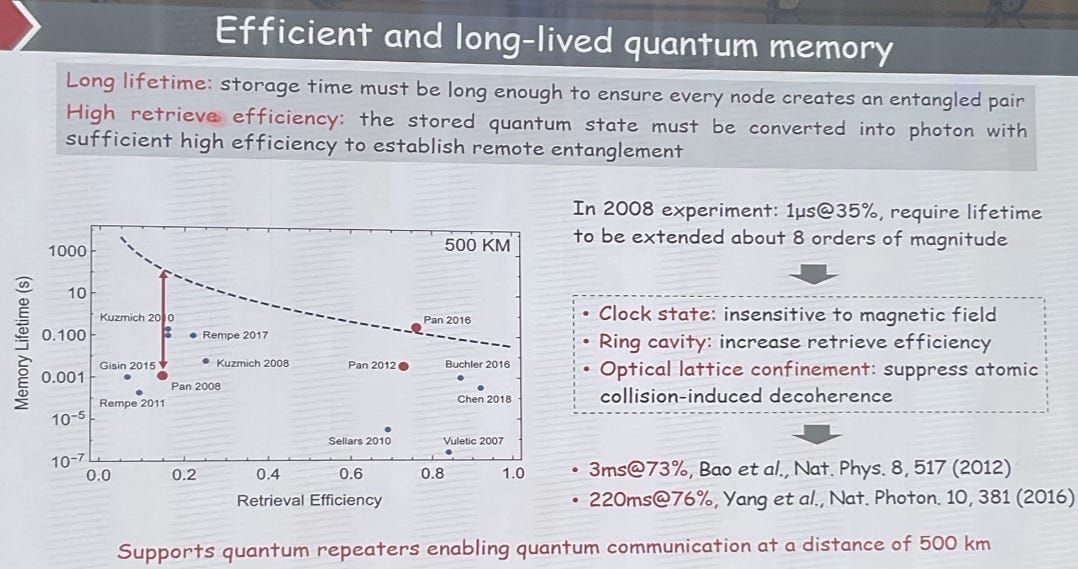
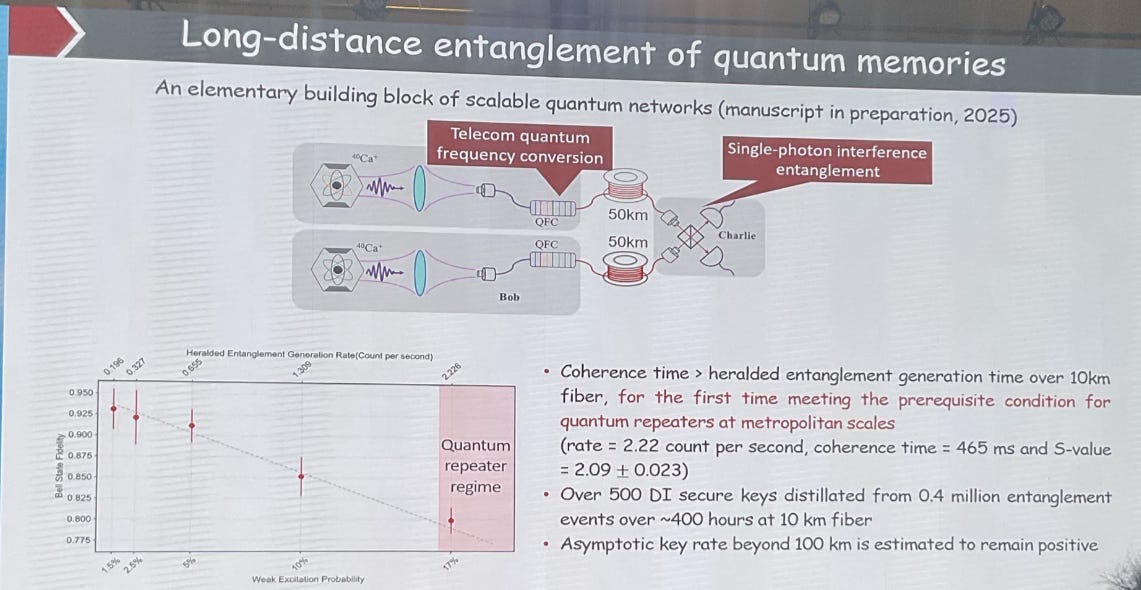
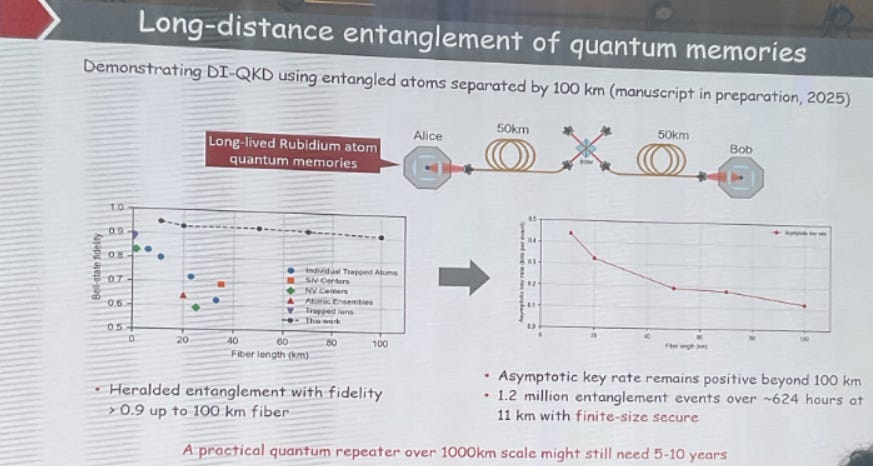
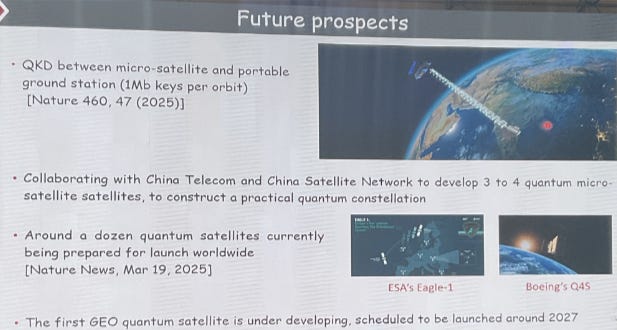

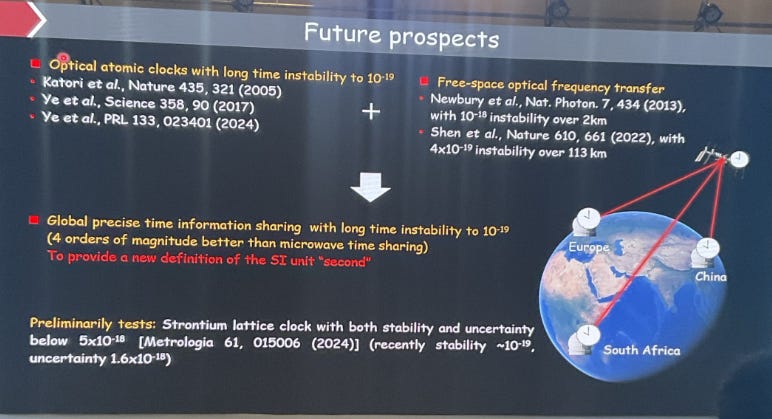

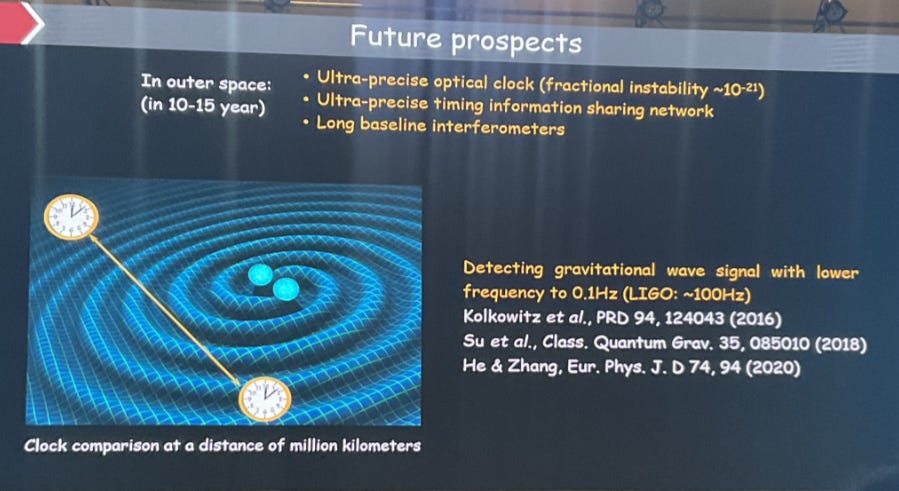
Wow thanks for spotlighting this. And for a theorist you know impressively much about hardware!